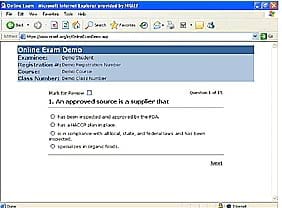Servsafe Manager Study Guide
Contamination by chemicals or other toxins is the final source of foodborne illnesses after bacteria, viruses, parasites, and mold. Food and Drug Administration lists chemical contaminants, metals, natural toxins, and pesticides as the primary causes of non-pathogenic foodborne illnesses. Natural toxins are generally a byproduct of food processing techniques, and do not include toxins associated with inherently poisonous foods, such as some species of mushrooms or fish.


Allergies are immunological conditions that are triggered by allergens, but allergic reactions are not considered a foodborne illness. Detergent is considered a chemical contaminant.
The Model 2000 Pull Type planter is available in vari. The information used in this manual was current at the. However, due to KINZE's continual. Give the Operator & Parts Manual to the customer and explain all operating. Your KINZE® planter has been carefully designed and sturdily built to provide. Kinze 2000 planter owners manual.
While detergent is often used in dishwashers and at the pot washing station, when it comes to consuming food, having a chemical detergent present in the food is certainly an example of a chemical hazard. Glycerol, also known as glycerine or propanetriol, is a non-toxic artificial sweetener, so it is not a contaminant.
Unwashed vegetables may have residual pesticides on them, but they are more likely to harbor biological contaminants such as disease. The level of water activity required for microbial growth is 0.85. Any level higher than this is considered an environment prone to bacterial growth. For this reason, it is important to treat all foods with water activities above this value as a potentially hazardous food. Water activity (aw) is a measurement of the moisture content of a food, expressed as a ratio of the vapor pressure in the food item in a given condition vs. The vapor pressure of distilled water in the same condition. The amount of unbound H2O molecules present in a food generally correlates directly to the likelihood of microbial growth on the food, including yeasts, molds, and bacteria.
If you return on Tuesday to find the refrigerator is broken, you should take all of the listed actions. First, you should call a repairman to fix the broken refrigerator. Second, you should throw away all the perishable or spoiled food in the refrigerator.
In kitchens, it is common to find non-perishable foods in a refrigerator, such as a sealed can of pickles. If this is the case, then you can save such foods, provided the containers have not been opened and are in the same state that you would find them in the dry storage area of your kitchen. All of the above.
While food safety risks are of concern to all people, children, the elderly, as well as people with deficient immune systems have a particular risk for food borne illness. This is due to the fragile nature of their immune systems. While adults might get sick from certain food borne pathogens (or even worse, die), children under the age of six, the elderly, and the immunodeficient tend to become sick quicker and the level of sickness is usually much more sever. For these reasons, it is important to be specifically careful when serving the three listed groups of people. All of the above.
To prevent contamination from your hands to raw foods served to your customers (such as salads), it is important to always have plastic gloves at each workstation in the kitchen. To prevent surface contamination of microbes, a red bucket full of diluted bleach should be at each station as well. No other red buckets should be found in the kitchen so that only red buckets are recognized as sanitation buckets. Finally, some form of head gear, such as plastic, paper, or mesh hats should be placed at each station to prevent hair from falling into the food. An air gap is the only way to prevent backflow in drainage and sewage systems.
This prevents harmful bacteria from seeping into sinks and other water receptacles in the restaurant. When designing your facility, make sure the contractor and architect are aware of the special requirement of food service establishments.
If you are converting an existing space to fit food safety safety standards, you may also install check valves, which function similarly to air gaps but do not require replacing non-compliant pipes. Local then State then Federal is the order in which to consult when making food safety decisions. First, check the Local ordinances for your food safety requirements, such as the City or County department of health.

Servsafe Manager Study Guide Spanish
Second, you should research the State government requirements to make sure you comply with them. Thirdly, you would use Federal resources. The Federal government gives the burden of food safety standards to the States when it comes to restaurants, since the State inspects restaurants.
Servsafe Manager Study Guide 6th Edition
Some Cities, such as New York City, have their own set or requirements. This means that NYC officials will inspect your restaurant instead of State or County representatives. For this reason, it is important to first check the Local requirements, followed by the State requirements, and finally using Federal resources for general information.